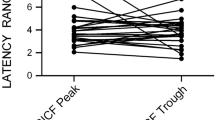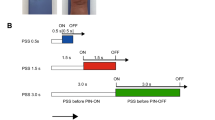Abstract
To clarify characteristics of each human somatosensory evoked field (SEF) component following passive movement (PM), PM1, PM2, and PM3, using high spatiotemporal resolution 306-channel magnetoencephalography and varying PM range and angular velocity. We recorded SEFs following PM under three conditions [normal range–normal velocity (NN), small range–normal velocity (SN), and small range–slow velocity (SS)] with changing movement range and angular velocity in 12 participants and calculated the amplitude, equivalent current dipole (ECD) location, and the ECD strength for each component. All components were observed in six participants, whereas only PM1 and PM3 in the other six. Clear response deflections at the ipsilateral hemisphere to PM side were observed in seven participants. PM1 amplitude was larger under NN and SN conditions, and mean ECD location for PM1 was at primary motor area. PM3 amplitude was larger under SN condition and mean ECD location for PM3 under SS condition was at primary somatosensory area. PM1 amplitude was dependent on the angular velocity of PM, suggesting that PM1 reflects afferent input from muscle spindle, whereas PM3 amplitude was dependent on the duration. The ECD for PM3 was located in the primary somatosensory cortex, suggesting that PM3 reflects cutaneous input. We confirmed the hypothesis for locally distinct generators and characteristics of each SEF component.







Similar content being viewed by others
References
Alary F et al (1998) Event-related potentials elicited by passive movements in humans: characterization, source analysis, and comparison to fMRI. NeuroImage 8:377–390. doi:10.1006/nimg.1998.0377
Alary F, Simoes C, Jousmaki V, Forss N, Hari R (2002) Cortical activation associated with passive movements of the human index finger: an MEG study. NeuroImage 15:691–696. doi:10.1006/nimg.2001.1010
Arezzo JC, Vaughan HG Jr, Legatt AD (1981) Topography and intracranial sources of somatosensory evoked potentials in the monkey. II. Cortical components. Electroencephalogr Clin Neurophysiol 51:1–18
Baumgartner U, Vogel H, Ohara S, Treede RD, Lenz FA (2010) Dipole source analyses of early median nerve SEP components obtained from subdural grid recordings. J Neurophysiol 104:3029–3041. doi:10.1152/jn.00116.2010
Burke D, Hagbarth KE, Lofstedt L (1978) Muscle spindle activity in man during shortening and lengthening contractions. J Physiol 277:131–142
Burke D, Gandevia SC, Macefield G (1988) Responses to passive movement of receptors in joint, skin and muscle of the human hand. J Physiol 402:347–361
Chang PH et al (2014) The cortical activation pattern by a rehabilitation robotic hand: a functional NIRS study. Front Hum Neurosci 8:49. doi:10.3389/fnhum.2014.00049
Cooper S (1961) The responses of the primary and secondary endings of muscle spindles with intact motor innervation during applied stretch. Q J Exp Physiol Cogn Med Sci 46:389–398
Desmedt JE, Ozaki I (1991) SEPs to finger joint input lack the N20-P20 response that is evoked by tactile inputs: contrast between cortical generators in areas 3b and 2 in humans. Electroencephalogr Clin Neurophysiol 80:513–521
Druschky K, Kaltenhauser M, Hummel C, Druschky A, Huk WJ, Neundorfer B, Stefan H (2003) omatosensory evoked magnetic fields following passive movement compared with tactile stimulation of the index finger. Exp Brain Res 148:186–195. doi:10.1007/s00221-002-1293-4
Duffy FH, Burchfiel JL (1971) Somatosensory system: organizational hierarchy from single units in monkey area 5. Science 172:273–275
Edin BB, Abbs JH (1991) Finger movement responses of cutaneous mechanoreceptors in the dorsal skin of the human hand. J Neurophysiol 65:657–670
Edin BB, Vallbo AB (1990) Dynamic response of human muscle spindle afferents to stretch. J Neurophysiol 63:1297–1306
Forss N et al (1994a) Activation of the human posterior parietal cortex by median nerve stimulation Experimental brain research 99:309–315
Forss N, Salmelin R, Hari R (1994b) Comparison of somatosensory evoked fields to airpuff and electric stimuli. Electroencephalogr Clin Neurophysiol 92:510–517
Ghosh S, Brinkman C, Porter R (1987) A quantitative study of the distribution of neurons projecting to the precentral motor cortex in the monkey (M. fascicularis). J Comp Neurol 259:424–444. doi:10.1002/cne.902590309
Goldring S, Ratcheson R (1972) Human motor cortex: sensory input data from single neuron recordings. Science 175:1493–1495
Hamalainen MS (1992) Magnetoencephalography: a tool for functional brain imaging. Brain Topogr 5:95–102
Hari R, Forss N (1999) Magnetoencephalography in the study of human somatosensory cortical processing. Philos Trans R Soc Lond B 354:1145–1154. doi:10.1098/rstb.1999.0470
Hari R, Hamalainen H, Hamalainen M, Kekoni J, Sams M, Tiihonen J (1990) Separate finger representations at the human second somatosensory cortex. Neuroscience 37:245–249
Hashimoto I (1987) Somatosensory evoked potentials elicited by air-puff stimuli generated by a new high-speed air control system. Electroencephalogr Clin Neurophysiol 67:231–237
Hoechstetter K et al (2000) Magnetic source imaging of tactile input shows task-independent attention effects in SII. NeuroReport 11:2461–2465
Houk JC, Rymer WZ, Crago PE (1981) Dependence of dynamic response of spindle receptors on muscle length and velocity. J Neurophysiol 46:143–166
Huang MX et al (2000) Sources on the anterior and posterior banks of the central sulcus identified from magnetic somatosensory evoked responses using multistart spatio-temporal localization. Hum Brain Mapp 11:59–76
Huttunen J, Ahlfors S, Hari R (1992) Interaction of afferent impulses in the human primary sensorimotor cortex. Electroencephalogr Clin Neurophysiol 82:176–181
Jones SJ, Power CN (1984) Scalp topography of human somatosensory evoked potentials: the effect of interfering tactile stimulation applied to the hand. Electroencephalogr Clin Neurophysiol 58:25–36
Kakigi R (1986) Ipsilateral and contralateral SEP components following median nerve stimulation: effects of interfering stimuli applied to the contralateral hand. Electroencephalogr Clin Neurophysiol 64:246–259
Kakigi R (1994) Somatosensory evoked magnetic fields following median nerve stimulation. Neurosci Res 20:165–174
Kakigi R et al (2000) The somatosensory evoked magnetic fields. Prog Neurobiol 61:495–523
Kawamura T, Nakasato N, Seki K, Kanno A, Fujita S, Fujiwara S, Yoshimoto T (1996) Neuromagnetic evidence of pre- and post-central cortical sources of somatosensory evoked responses. Electroencephalogr Clin Neurophysiol 100:44–50
Kida T, Wasaka T, Inui K, Akatsuka K, Nakata H, Kakigi R (2006) Centrifugal regulation of human cortical responses to a task-relevant somatosensory signal triggering voluntary movement. NeuroImage 32:1355–1364. doi:10.1016/j.neuroimage.2006.05.015
Kida T, Inui K, Wasaka T, Akatsuka K, Tanaka E, Kakigi R (2007) Time-varying cortical activations related to visual-tactile cross-modal links in spatial selective attention. J Neurophysiol 97:3585–3596. doi:10.1152/jn.00007.2007
Lange R, Nowak H, Haueisen J, Weiller C (2001) Passive finger movement evoked fields in magnetoencephalography. Exp Brain Res 136:194–199
MacKay WA, Kwan MC, Murphy JT, Wong YC (1978) Responses to active and passive wrist rotation in area 5 of awake monkeys. Neurosci Lett 10:235–239
Mima T, Terada K, Maekawa M, Nagamine T, Ikeda A, Shibasaki H (1996) Somatosensory evoked potentials following proprioceptive stimulation of finger in man. Exp Brain Res 111:233–245
Mima T, Nagamine T, Nakamura K, Shibasaki H (1998) Attention modulates both primary and second somatosensory cortical activities in humans: a magnetoencephalographic study. J Neurophysiol 80:2215–2221
Mima T, Sadato N, Yazawa S, Hanakawa T, Fukuyama H, Yonekura Y, Shibasaki H (1999) Brain structures related to active and passive finger movements in man. Brain 122:1989–1997
Mountcastle VB, Lynch JC, Georgopoulos A, Sakata H, Acuna C (1975) Posterior parietal association cortex of the monkey: command functions for operations within extrapersonal space. J Neurophysiol 38:871–908
Onishi H, Oyama M, Soma T, Kubo M, Kirimoto H, Murakami H, Kameyama S (2010) Neuromagnetic activation of primary and secondary somatosensory cortex following tactile-on and tactile-off stimulation. Clin Neurophysiol 121:588–593. doi:10.1016/j.clinph.2009.12.022
Onishi H, Oyama M, Soma T, Kirimoto H, Sugawara K, Murakami H, Kameyama S (2011) Muscle-afferent projection to the sensorimotor cortex after voluntary movement and motor-point stimulation: an MEG study. Clin Neurophysiol 122:605–610. doi:10.1016/j.clinph.2010.07.027
Onishi H et al (2013a) Effect of the number of pins and inter-pin distance on somatosensory evoked magnetic fields following mechanical tactile stimulation. Brain Res 1535:78–88. doi:10.1016/j.brainres.2013.08.048
Onishi H et al (2013b) Neuromagnetic activation following active and passive finger movements. Brain Behav 3:178–192. doi:10.1002/brb3.126
Radovanovic S et al (2002) Comparison of brain activity during different types of proprioceptive inputs: a positron emission tomography study. Exp Brain Res 143:276–285. doi:10.1007/s00221-001-0994-4
Reddy H, Floyer A, Donaghy M, Matthews PM (2001) Altered cortical activation with finger movement after peripheral denervation: comparison of active and passive tasks. Exp Brain Res 138:484–491
Sakata H, Takaoka Y, Kawarasaki A, Shibutani H (1973) Somatosensory properties of neurons in the superior parietal cortex (area 5) of the rhesus monkey. Brain Res 64:85–102
Stepniewska I, Sakai ST, Qi HX, Kaas JH (2003) Somatosensory input to the ventrolateral thalamic region in the macaque monkey: potential substrate for parkinsonian tremor. J Comp Neurol 455:378–395. doi:10.1002/cne.10499
Sulzer J, Duenas J, Stampili P, Hepp-Reymond MC, Kollias S, Seifritz E, Gassert R (2013) Delineating the whole brain BOLD response to passive movement kinematics. In: IEEE International conference on rehabilitation robotics 2013:6650474. doi:10.1109/ICORR.2013.6650474
Szameitat AJ, Shen S, Conforto A, Sterr A (2012) Cortical activation during executed, imagined, observed, and passive wrist movements in healthy volunteers and stroke patients. NeuroImage 62:266–280. doi:10.1016/j.neuroimage.2012.05.009
Takeuchi N, Izumi S (2013) Rehabilitation with poststroke motor recovery: a review with a focus on neural plasticity Stroke research and treatment 2013:128641. doi:10.1155/2013/128641
Terumitsu M, Ikeda K, Kwee IL, Nakada T (2009) Participation of primary motor cortex area 4a in complex sensory processing: 3.0-T fMRI study. NeuroReport 20:679–683. doi:10.1097/WNR.0b013e32832a1820
Weiller C et al (1996) Brain representation of active and passive movements. NeuroImage 4:105–110. doi:10.1006/nimg.1996.0034
Xiang J et al (1997a) Somatosensory evoked magnetic fields following passive finger movement. Cogn Brain Res 6:73–82
Xiang J, Kakigi R, Hoshiyama M, Kaneoke Y, Naka D, Takeshima Y, Koyama S (1997b) Somatosensory evoked magnetic fields and potentials following passive toe movement in humans. Electroencephalogr Clin Neurophysiol 104:393–401
Yamashiro K, Inui K, Otsuru N, Kida T, Kakigi R (2009) Somatosensory off-response in humans: an MEG study. NeuroImage 44:1363–1368. doi:10.1016/j.neuroimage.2008.11.003
Zarzecki P, Shinoda Y, Asanuma H (1978) Projection from area 3a to the motor cortex by neurons activated from group I muscle afferents. Exp Brain Res 33:269–282
Acknowledgments
This study was supported by a Grant-in-Aid for scientific research (B) 25282162 and Young Scientists (B) 26750203 from the Japan Society for the Promotion of Science (JSPS) and a Grant-in-Aid for Advanced Research from Niigata University of Health and Welfare.
Author information
Authors and Affiliations
Corresponding author
Ethics declarations
Conflict of interest
None.
Rights and permissions
About this article
Cite this article
Sugawara, K., Onishi, H., Yamashiro, K. et al. Effect of Range and Angular Velocity of Passive Movement on Somatosensory Evoked Magnetic Fields. Brain Topogr 29, 693–703 (2016). https://doi.org/10.1007/s10548-016-0492-4
Received:
Accepted:
Published:
Issue Date:
DOI: https://doi.org/10.1007/s10548-016-0492-4




